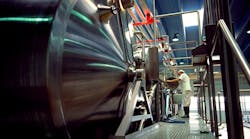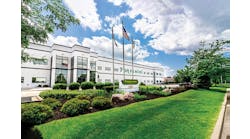The hot breath of a Walmart supplier-relations officer can light a fire under manufacturers to measure and report greenhouse gas (GHG) emissions as part of the retailer’s supply chain objectives. Exhibit A is the sustainability program from the Innovation Center for U.S. Dairy.
Beginning in 2013, the beast of Bentonville began using the Sustainability Index when evaluating private label suppliers. By 2017, the retailer has pledged to purchase 70 percent of all goods in its U.S. stores from suppliers who use the index to assess their GHG contributions. That inspired the Innovation Center to fund research projects and develop tools that dairy processors can use to calculate the carbon footprint of their products.
While almost three-quarters of dairy products’ GHG emissions occur at the farm level, some processors are taking the lead and developing robust programs to reduce the inputs they control. Research commissioned by the Innovation Center calculates the total carbon footprint of fluid milk is 35 million metric tons, with 5.7 percent attributable to processing, 3.5 percent to packaging and 7.7 percent to distribution.
“Sustainability makes sense and makes dollars and cents in many cases,” maintains Chad Frahm, the Innovation Center’s vice president-business development in Rosemont, Ill. “Dairy farmers have focused on stewardship and sustainability forever, but what has not happened is telling that story. Leadership is trying to be very proactive and stay ahead of consumer expectations by developing a framework that the industry and everyone else can coalesce around.”
Walmart, McDonald’s and other major customers have seats on the center’s Sustainability Council, as do Non-governmental organizations such as the World Wildlife Federation are helping to spotlight pacesetters among the nation’s 1,000-plus dairy plants producing fluid milk, cheese, cultured products and other foods. The council’s goal: a 25 percent GHG reduction for dairy producers and processors by 2020.
That’s a lofty ambition, but some dairies are well on their way to achieving it. Darigold Inc., the Seattle-based processing arm of the Northwest Dairy Assn., had to move its goalposts after carving $6.4 million from energy costs (5.4 percent) from 2005-2009. Additional efficiencies have made Darigold more competitive in global trade of milk powders.
A gas engine (yellow) that drives a compressor is pictured, with a similarly sized electric compressor in the background. Natural-gas pricing has made gas-powered compressors economically attractive. PHOTO: Solution Dynamics LLC
New Zealand, with its pasture-based herds, maintains low-cost supplier status, but “we’re often the second supplier,” says Steven Rowe, general counsel and senior vice president-corporate affairs at Darigold. In fiscal 2011, the processor rang up $514 million in export sales, with two-fifths of solids production shipped to Asian markets.
America’s dairy exports are booming, projected to reach a record $6.6 billion in 2013, up 30 percent from 2012. Exports accounted for 16.3 percent of milk solids produced nationwide in October.
Room for improvement
Efficient re-use of energy has been a dairy hallmark since the 19th Century, but many opportunities for energy reductions remain, beginning with the refrigeration system.
“Most dairies could cut their energy bill by 20 percent, some by as much as 40 percent, and that has a big impact on the bottom line,” suggests Calvin Wohlert, principal of Solution Dynamics, an Olathe, Kan., energy consultant and a member of the Sustainability Council. A project involving an ice cream manufacturer slashed energy costs $253,000 and produced a simple payback in 22 months. Integrators installed a master sequencing control system. Additional improvements involved variable frequency drive retrofits on several condensers and other system fine tuning.
Retailers are peppering dairies with information requests about their sustainability efforts, Wohlert notes, adding “the pressure exerted by the supply chain” is driving the efforts of dairy leaders. Buy-in is by no means universal; he characterizes the current landscape as “a mixed bag” of organizations that are aggressively attacking waste and those sitting on the sidelines. For those pursuing efficiency improvements, the most effective programs begin with an energy audit, as opposed to “charging down the path, chasing bright, shiny objectives.”
New opportunities present themselves with the widening of the “spark gap” -- the differential between electricity and natural gas costs. An old idea that is new again is the coupling of refrigeration compressors with gas engines.
Reusing the engine’s waste heat for boiler feed water and other uses provides a decisive cost advantage over electricity, says Wohlert, citing a comparison study he conducted for a dairy with both gas and electric compressors. True, a gas engine must be rebuilt after 50,000 hours of run time, but “even with the added maintenance cost, it was a lot more efficient to run a gas compressor than an electric one,” he says.
Gas of a liquid consistency is the biggest source of GHG emissions attributed to fluid milk facilities: Vehicular tailpipe emissions account for 29 percent of the total, ahead of electricity’s 27 percent, concludes a study published in the International Dairy Journal.
At Oakhurst Dairy, Portland, Maine, the use of biodiesel is “the single biggest impact we’ve been able to make,” according to John Bennett, president of the family-owned firm. The 130,000-plus gallons that helped power the delivery fleet cut emissions 70 percent and cost less than straight diesel.
Oakhurst had a strong environmental record long before it was recognized with a sustainability award from the Innovation Center in 2012. The dairy has been a major contributor to reforestation efforts in its home town and throughout the state, and 10 percent of annual profits is earmarked for groups that support a healthy environment and healthy children. The dairy was an early convert to environmentally friendly refrigerants in trailers. But its nurturing of the biofuels business in general and support for Maine Standard Biofuels, its local supplier, may be having the biggest impact.
Oakhurst was one of the few takers when the state tried to kick-start the use of biodiesel. Soy-based biofuel initially was introduced in a 20:80 mix, and when a state subsidy ran out, the economics became unfavorable. When the organizers of Maine Standard unveiled a plan to collect fryer grease from area restaurants and convert it to biodiesel, Oakhurst management supported the effort by prepaying for the finished product. The purer fuel resolved filter issues and allowed the dairy to increase the blend ratio to as much as 70:30 in warm weather, without any engine modifications.
“Walmart is all about reducing cost and doing that through sustainability initiatives,” reflects Oakhurst Chairman Bill Bennett. Farm-level activities overwhelmingly affect dairy’s GHG scorecard, and Oakhurst is committed to helping its milk suppliers tackle capital-intense solutions. For example, seed money to study the feasibility of biogas from anaerobic digesters was provided to two farmers.
Hitting a dry spot
Agriculture and power plants account for an overwhelming proportion of U.S. water consumption, which can make water conservation efforts by processors seem somewhat futile. But while big reductions are attainable -- Darigold reduced water per pound of finished goods 15 percent from 2005 to 2011 -- low water prices and the need to maintain high hygiene standards discourage many dairies from addressing water use.
Shorter CIP cycles mean more uptime and greater throughput in dairies, and rotating spray balls are one way to accelerate CIP and reduce water use. PHOTO: Alfa Laval
“It is a water-intensive process,” allows Wohlert, and reducing consumption is “tough, because it’s hard to get an economic justification.” Tweaks to standard practices can produce savings, like reusing final rinse water in a CIP cycle for the first rinse in the next cycle. Another option is replacing static spray balls in the CIP system with rotating spray balls.
Water savings vary significantly, depending on the application, but reductions in the 30-50 percent range are a reasonable rule of thumb, one technology provider indicates. The bigger payoff, however, is in the savings in time and chemical use.
About six years ago, Alfa Laval gained 3-A certification for a rotating spray ball adapted from technology developed by a specialist in marine tank cleaning systems. Last year, Alfa Laval added a complementary line from Exton, Pa.-based Gamajet to its portfolio and renamed the division Alfa Laval Tank Equipment, Kenosha, Wis.
In an application involving an unnamed Wisconsin cheese maker, a system installed in two cooling baths replaced five static sprayballs with three rotating devices. CIP routines were performed 3-4 times a week, and the system shaved a third of cycle time, reducing it to 28 minutes. Water use per cycle declined 12-fold, reducing costs to $59 from $723. Downtime reductions enabled the plant to run 28 additional batches per year, about a 3 percent boost in throughput.
Some dairies, such as Oakhurst, are unabashed about discussing the social and environmental aspects of sustainable practices, but pushback against those elements is undeniable. “I have divorced the issues from the ideological fears of the industry and focus on the principles of resource management,” Darigold’s Rowe says. “If I talk about the right thing to do, I’ve lost.” Instead, “the brutal truth” about the cost of waste should drive the discussion.
Elimination of waste often requires capital investment, and customers must acknowledge and account for the cost of sustainability. “Walmart has learned dairy production is an important part of the supply chain, and they’ve started down a path with a lot of bold talk,” Rowe muses. Mainstream dairies may not meet target dates for GHG reductions, but he believes they ultimately will realize those reductions in the course of instituting good business practices that optimize production and distribution.


